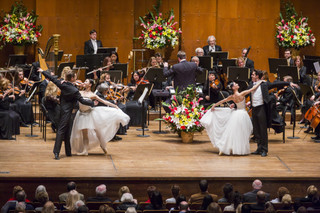|
Back
Here’s to 2018! Orange County
Renée and Henry Segerstrom Concert Hall
12/29/2017 - & 30 December 2017 (San Diego), 01 January 2018 (Los Angeles)
Johann Strauss, Jr.: Die Fledermaus: “Overture”; “Spiel’ ich die Unschuld vom Lande”; “Dieser Anstand, so manierlich” – Morgenblätter waltz, opus 279 – Im Krapfenwald’l polka française – Entweder-oder! polka, opus 403 – Tales from the Vienna Woods waltz, opus 325 – Freikugeln polka, opus 326 – Thunder and Lightning polka, opus 324 – An der schönen blauen Donau, opus 314 (encore)
Franz Lehár: Friederike: “O Mädchen, mein Mädchen” – Das Land des Lächelns: “Overture” – The Merry Widow: “Da geh’ ich zu Maxim; “Lippen Schweigen” (encore)
Josef Strauss: Mein Lebenslauf ist Lieb und Lust waltz, opus 263
Jacques Offenbach: Les Contes d’Hoffmann: “Les oiseaux dans la charmille”
Emmerich Kálmán: Countess Maritza: “Komm mit nach Varazdin”
Katarzyna Donaldska (soprano), Alexander Kaimbacher (tenor)
Kiev-Aniko Ballet of Ukraine
Strauss Symphony of America, András Deák (conductor)
Aniko Rekhviasvili (choreography and costumes), International Champion Ballroom Dancers, Csaba László (choreography), Szilvia Szatmári-Nagy (costumes)

(© Chris Lee)
For over 20 years Marion and Attila Glatz, founders of the Attila Glatz Concert Productions, have rung in the New Year filling the air with infusions of Viennese music across more than a dozen cities in North America. Once again, Orange County is the first stop on this West Coast tour ahead of welcoming 2018.
The frequent hopscotching into opera, ballet, ballroom dancing and symphony makes for a stimulating and briskly forward evening. Principal conductor of the Danube Symphony Orchestra, András Deák, leads a well-paced Strauss Symphony of America and adds his own lighthearted narration without being a “scenery chewer.” The vivacious “Overture” to Die Fledermaus brightens The Hall though the strings get a bit muddled inside the composition’s climax.
As if to mirror the first half of the program, upon commencement of the intermission we hear delights of yet another “Overture” from Lehár’s Das Land des Lächelns (The Land of Smiles) with its emotionally searing solo violin enclave and harp runs. The horn section has a particularly rocky night with sloppy lead-ins to not only this piece but also in The Blue Danube Waltz. Symphonic blending, on balance, is sufficient, though the orchestra appears to be on “cruise control.”
Katarzyna Dondalska is one of the highlights of the evening, particularly when singing her own arias. A bit brassy around the edges, this coloratura has some of the most extraordinary precision in today’s operatic world. After delivering a spunky rendition of “Spiel’ ich die Unschuld vom Lande”, her momentous delivery is found inside Offenbach’s “Les oiseaux dans la charmille.” Excessively spoofy and blatantly humorous, Mlle. Dondalska’s gesticulations are a result of clever crafting, alongside improvisational coloratura which excels beyond expectations: there’s an uncanny maničre of pinching the highest of notes without hinting at timidity or exhaustion...her fermatas go on forever and reach into outer orbit! Fabulous delivery.
Not to be outdone, but our tenor-of-the-evening, Alexander Kaimbacher, has his moments in the spotlight. The seldom heard aria from Friederike, a lovely passage, indeed, lends problems in the sound magnification department with microphone enhancement destroying the articulation. Danilo’s “Da geh’ ich zu Maxim” is an exemplary fit inside M. Kaimbacher’s tessitura, but the auditory pathway diminishes one’s ability to really understand and hear the quality in this Austrian’s voice. [This issue only exacerbates itself when Dondalska and Kaimbacher pair up in the “Watch Duet” and the duet from Countess Maritza...somehow Dondalska escapes such atrocities.]
Where we find the other artistic extension is within dance, both ballet and ballroom dancing. Choreographers Aniko Rekhviasvili and Csaba László deal effectively with the space limitations on stage which make for some fluidic and creative extensions despite the cornball dress sized up by both Rekhviasvili and Szatmári-Nagy. Faster pieces, namely, Im Krapfenwald’l polka française and the Entweder-oder! polka are eye-catching and infectious. Some of the male balletic movements trend cardboard.
As with any grand event such as this, an encore or two are planned, and in this production Marion and Attila Glatz choose An der schönen blauen Donau (The Blue Danube Waltz) in closing out 2017.
Christie Grimstad
|